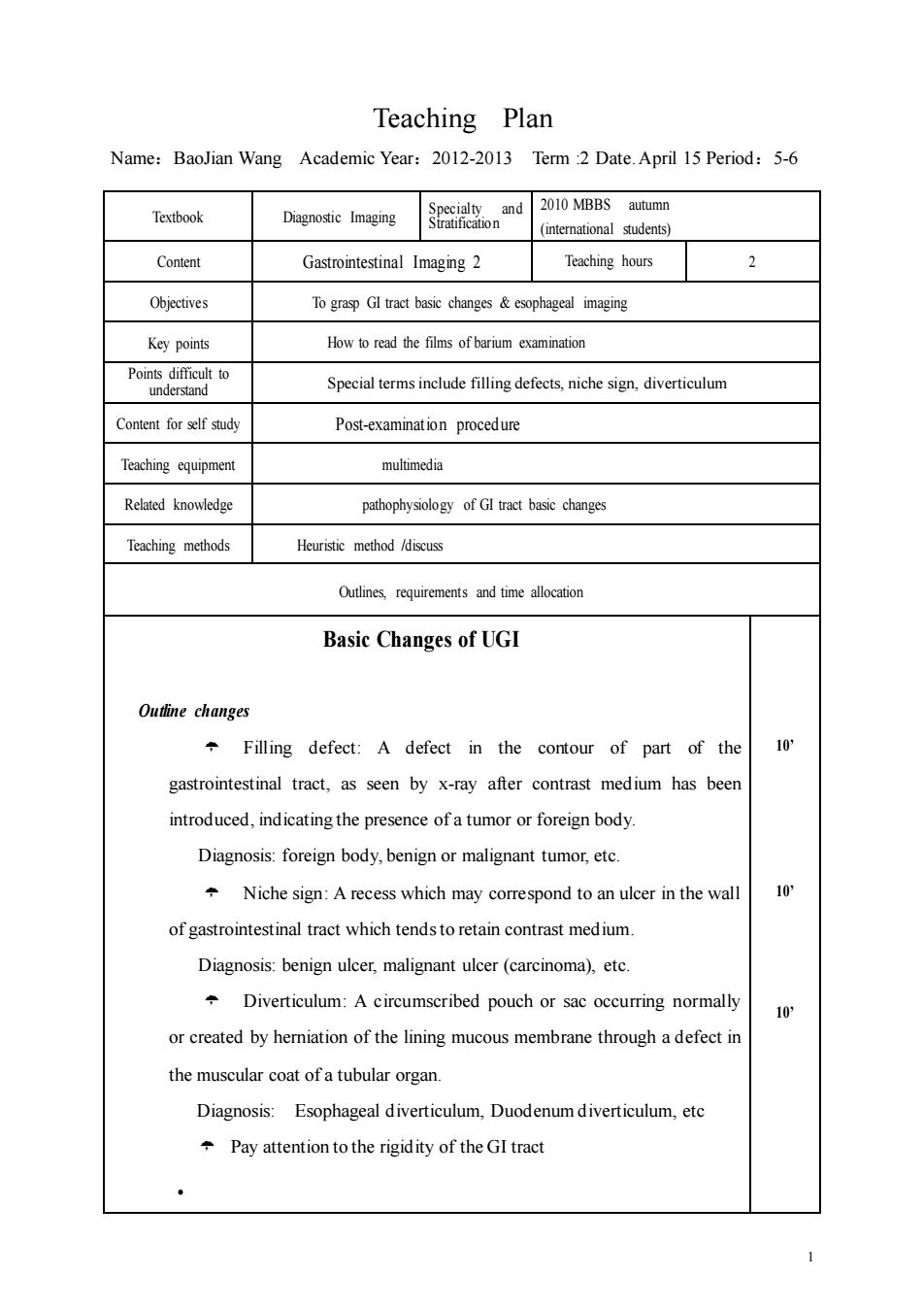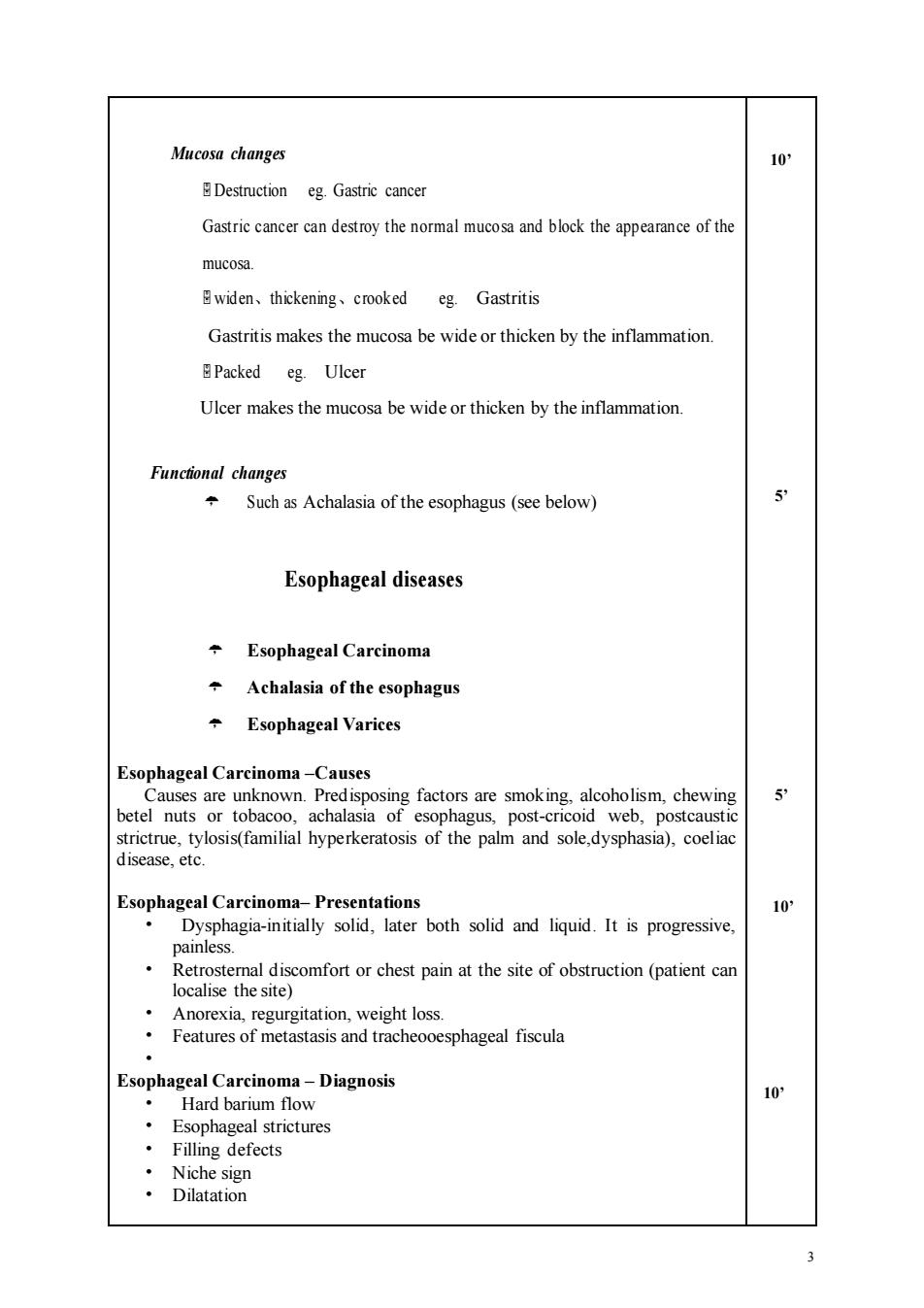
Teaching Plan Name:BaoJian Wang Academic Year:2012-2013 Term:2 Date.April 15 Period:5-6 Textbook Diagnostic Imaging nnd2010 MBS um atcmatonalstudents Conient Gastrointestinal Imaging 2 Teaching hours 2 Objectives To grasp Gl tract basic changes esophageal imaging Key points How to read the films of barium examination Poo Special terms include filling defects,niche sign.diverticulum Content for self study Post-examination procedure Teaching equipment multimedia Related knowedge hophysogf tract basic changs Teaching methods Heuristic method /discuss Outlines requirements and time allcn Basic Changes of UGI Outine changes Filling defect:A defect in the contour of part of the 10 gastrointestinal tract,as seen by x-ray after contrast medium has been introduced,indicating the presence ofa tumoror foreign body. Diagnosis:foreign body,benign or malignant tumor,etc. Niche sign:A recess which may correspond to an ulcer in the wall 10 of gastrointestinal tract which tends to retain contrast medium Diagnosis:benign ulcer,malignant ulcer(carcinoma).ete. Diverticulum:A circumscribed pouch or sac occurring normally 10 or created by hemiation of the lining mucous membrane through a defect in the muscular coat of a tubular organ. Diagnosis:Esophageal diverticulum,Duodenum diverticulum,etc Pay attention to the rigidity of the GI tract
1 Teaching Plan Name:BaoJian Wang Academic Year:2012-2013 Term :2 Date.April 15 Period:5-6 Textbook Diagnostic Imaging Specialty and Stratification 2010 MBBS autumn (international students) Content Gastrointestinal Imaging 2 Teaching hours 2 Objectives To grasp GI tract basic changes & esophageal imaging Key points How to read the films of barium examination Points difficult to understand Special terms include filling defects, niche sign, diverticulum Content for self study Post-examination procedure Teaching equipment multimedia Related knowledge pathophysiology of GI tract basic changes Teaching methods Heuristic method /discuss Outlines, requirements and time allocation Basic Changes of UGI Outline changes Filling defect: A defect in the contour of part of the gastrointestinal tract, as seen by x-ray after contrast medium has been introduced, indicating the presence of a tumor or foreign body. Diagnosis: foreign body, benign or malignant tumor, etc. Niche sign: A recess which may correspond to an ulcer in the wall of gastrointestinal tract which tends to retain contrast medium. Diagnosis: benign ulcer, malignant ulcer (carcinoma), etc. Diverticulum: A circumscribed pouch or sac occurring normally or created by herniation of the lining mucous membrane through a defect in the muscular coat of a tubular organ. Diagnosis: Esophageal diverticulum, Duodenum diverticulum, etc Pay attention to the rigidity of the GI tract • 10’ 10’ 10’

Outlines requirements and time allocation Sie changes Stricture: 15 Inflammation eg.Severe Oesophagitis Severe and long-standing inflammation it can cause scarring and narrowing (a stricture)of the lower oesophagus.This is uncommon. Tumor eg.Esophageal Carcinoma Dysphagia(difficulty swallowing)and odynophagia(painful swallowing) are the most common symptoms of esophageal carcinoma.Dysphagia is the first symptom in most patients.Odynophagia may also be present. Fluids and soft foods are usually tolerated,while hard or bulky substances (such as bread or meat)cause much more difficulty .Compression eg.Esophagus compressed by Left atrial enlargement Congenital disease eg.Congenital esophageal stenosis is thought to be a rare developmental anomaly,occurring in only one of 25.000-50.000 live births.It has been postulated that this condition results from abnormal embryologic development-defective canalization of the esophagus caused by intrauterine anoxia. .Adherence eg.Abdominal adhesions(or intra-abdominal adhesions ~are most commonly caused by abdominal surgical procedures.The adhesions start to form within hours after surgery and may cause intemal organs to attach to the surgical site or to other organs in the abdominal cavity. Spasm eg.Stomach spasms ~are uncontrollable muscular movements in the abdominal area.They may be sudden and painful.Stomach spasms can cause stomach stricture. Expansion:can caused by obstruction
2 Outlines, requirements and time allocation Size changes Stricture: • Inflammation eg. Severe Oesophagitis Severe and long-standing inflammation it can cause scarring and narrowing (a stricture) of the lower oesophagus. This is uncommon. • Tumor eg. Esophageal Carcinoma Dysphagia (difficulty swallowing) and odynophagia (painful swallowing) are the most common symptoms of esophageal carcinoma. Dysphagia is the first symptom in most patients. Odynophagia may also be present. Fluids and soft foods are usually tolerated, while hard or bulky substances (such as bread or meat) cause much more difficulty. • Compression eg. Esophagus compressed by Left atrial enlargement • Congenital disease eg. Congenital esophageal stenosis ~ is thought to be a rare developmental anomaly, occurring in only one of 25,000-50,000 live births. It has been postulated that this condition results from abnormal embryologic development—defective canalization of the esophagus caused by intrauterine anoxia. • Adherence eg. Abdominal adhesions (or intra-abdominal adhesions) ~ are most commonly caused by abdominal surgical procedures. The adhesions start to form within hours after surgery and may cause internal organs to attach to the surgical site or to other organs in the abdominal cavity. • Spasm eg. Stomach spasms ~ are uncontrollable muscular movements in the abdominal area. They may be sudden and painful. Stomach spasms can cause stomach stricture. Expansion: can caused by obstruction 15’ 5’

Mucosa changes Destruction eg.Gastric cancer Gastric cancer can destroy the normal mucosa and block the appearance of the mucosa widen、thickening、crooked eg.Gastritis Gastritis makes the mucosa be wide or thicken by the inflammation. Packed eg.Ulcer Ulcer makes the mucosa be wide or thicken by the inflammation Functional changes Such as Achalasia of the esophagus(see below) 5 Esophageal diseases Esophageal Carcinoma Achalasia of the esophagus ÷Esophageal Varices Esophageal Careinoma-Causes betel nown.Pre sposing fact rs are smoking,alcoholism,chewing al strictrue the dise ilial hyperkeratosis Esophageal Carcinoma-Presentations 10 Dysphagia-initially solid,later both solid and liquid.It is progressive, painless mal discomfort or chest pain at the site of obstruction(patient can .Anorexia,regurgitation,weight loss. .Features of metastasis and tracheooesphageal fiscula Esophageal Carcinoma-Diagnosis Hard barium flow 10
3 Mucosa changes Destruction eg. Gastric cancer Gastric cancer can destroy the normal mucosa and block the appearance of the mucosa. widen、thickening、crooked eg. Gastritis Gastritis makes the mucosa be wide or thicken by the inflammation. Packed eg. Ulcer Ulcer makes the mucosa be wide or thicken by the inflammation. Functional changes Such as Achalasia of the esophagus (see below) Esophageal diseases Esophageal Carcinoma Achalasia of the esophagus Esophageal Varices Esophageal Carcinoma –Causes Causes are unknown. Predisposing factors are smoking, alcoholism, chewing betel nuts or tobacoo, achalasia of esophagus, post-cricoid web, postcaustic strictrue, tylosis(familial hyperkeratosis of the palm and sole,dysphasia), coeliac disease, etc. Esophageal Carcinoma– Presentations • Dysphagia-initially solid, later both solid and liquid. It is progressive, painless. • Retrosternal discomfort or chest pain at the site of obstruction (patient can localise the site) • Anorexia, regurgitation, weight loss. • Features of metastasis and tracheooesphageal fiscula • Esophageal Carcinoma – Diagnosis • Hard barium flow • Esophageal strictures • Filling defects • Niche sign • Dilatation 10’ 5’ 5’ 10’ 10’

Achalasia of the esophagus sphi due to System may be degenerative change of vagus nerve nuclei in the brain g
4 Achalasia of the esophagus • A motility disorder charaterised by failure to dilate the lower esophagus sphincter due to absence or reduction of the ganglion cells of Auerbach’s plexus. • There may be degenerative change of vagus nerve nuclei in the brain system. 10’